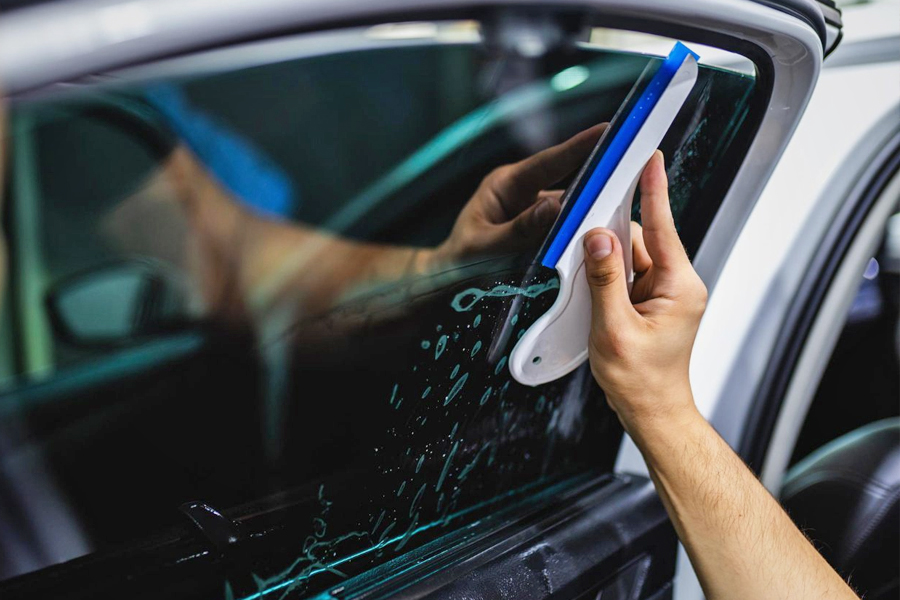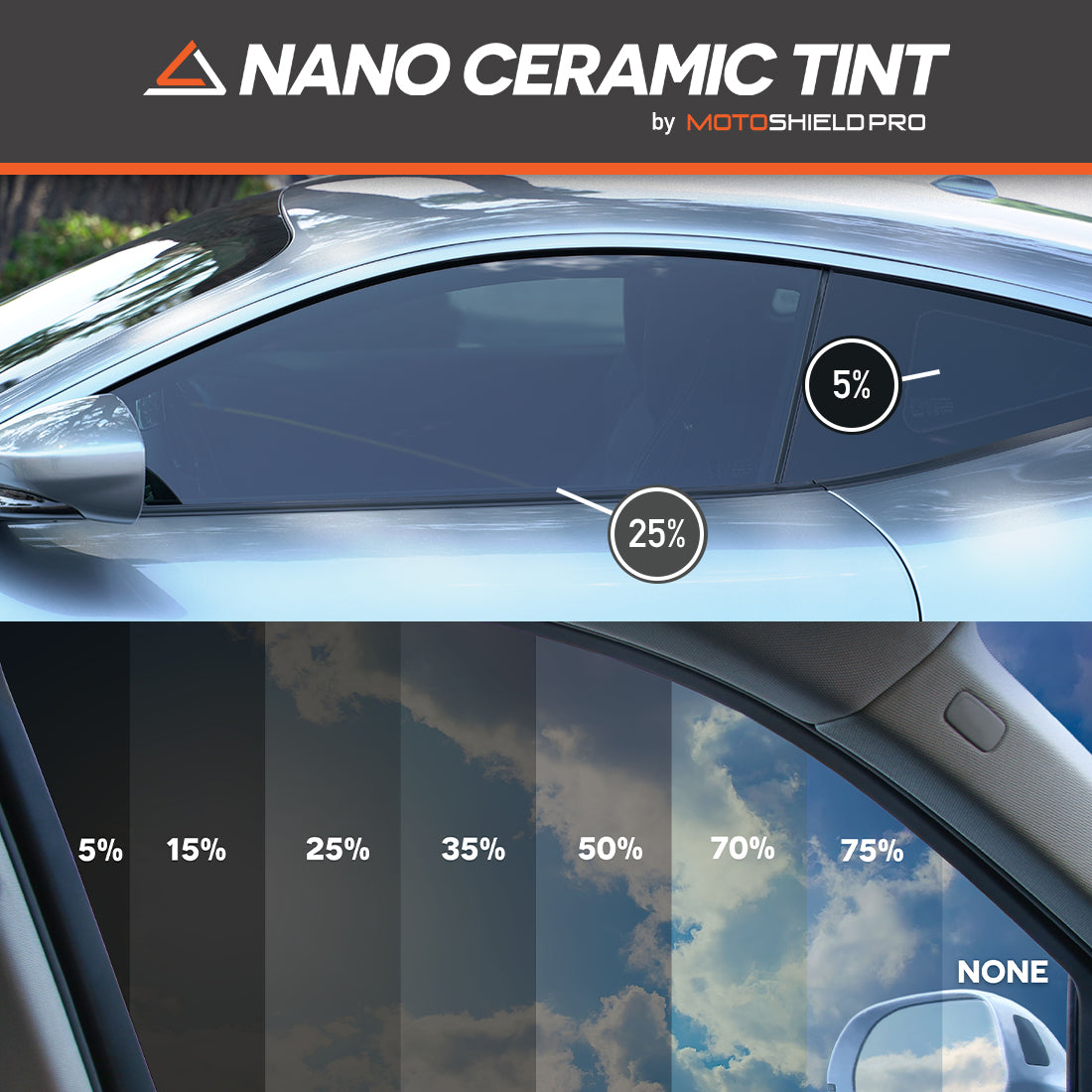A Comprehensive Overview to Recognizing Vehicle Home Window Color and Its Advantages
Vehicle window tinting offers more than simply a visual purpose for automobiles. It offers different types, each with distinctive features and benefits. Recognizing these choices, along with lawful guidelines and maintenance ideas, is important for any kind of automobile owner. The advantages may significantly enhance driving convenience and vehicle longevity. As one checks out the subtleties of home window tinting, the question develops: what kind of color is ideal suited for private requirements?
Comprehending Vehicle Window Color: What It Is and Just how It Works
Car window tint acts as a safety barrier that enhances car looks while providing functional benefits. This thin movie is related to the interior surface area of car home windows, minimizing glow and obstructing unsafe ultraviolet (UV) rays from the sun. By filtering sunshine, auto window tint assists to control the interior temperature level of the lorry, causing boosted convenience for guests and reduced reliance on air conditioning.Additionally, it shields the vehicle's interior from fading, protecting both upholstery and control panel materials. The color can also enhance privacy, making it harder for outsiders to see inside the lorry. Additionally, specific types of window tint can enhance safety; in case of an accident, the film aids hold shattered glass together, minimizing the risk of injury from flying shards. Generally, vehicle window color serves both visual and sensible purposes, making it a prominent selection amongst lorry owners.
Kinds Of Window Tint: A Summary of Options
When taking into consideration home window tint options, several types are offered, each with distinctive features. Colored, metalized, and ceramic window tints provide differing levels of warm rejection, UV security, and visual appeal. Recognizing these differences can assist vehicle owners make notified choices based upon their choices and needs.
Colored Home Window Color
Dyed home window color represents a prominent option amongst auto owners seeking a cost effective and efficient way to enhance their automobile's aesthetic appeals and personal privacy. This kind of color is developed by positioning a layer of color in between a protective covering and a glue layer, causing a dark look that reduces glow and enhances visual convenience. While colored home window tint effectively obstructs harmful UV rays, it might not offer the exact same level of heat denial as various other color kinds. In addition, its color can discolor over time, possibly lessening its effectiveness. Despite these disadvantages, dyed window color remains favored for its cost-effectiveness and ability to offer a sleek, fashionable look to numerous car designs.
Metalized Window Tint
Metalized home window tint offers an equilibrium of design and performance, making it a popular choice among car proprietors. This kind of color includes metallic bits within the film, enhancing both aesthetic appeal and heat rejection. The reflective top quality of metalized tint assists to minimize glare and enhance privacy, while additionally supplying UV security, which safeguards the automobile's inside. Furthermore, metalized home window color can reinforce window toughness, potentially stopping smashing throughout crashes. It is essential to note that the metallic elements can conflict with electronic signals, such as GPS and cell phone reception. In general, metalized window color gives a reliable service for those seeking a mix of sun, appearance, and longevity protection for their automobiles.
Ceramic Window Tint
Ceramic home window tint stands for a sophisticated option in the range of auto window films, offering distinct advantages over conventional colors. Unlike dyed or metalized movies, ceramic tints use innovative ceramic particles, which properly deny warm and UV rays without jeopardizing exposure. This technology assures that automobiles stay cooler, decreasing dependence on air conditioning and boosting fuel performance. Furthermore, ceramic window colors are much less likely to hinder digital devices, such as GPS or mobile signals, making them a functional choice for modern automobiles. Their sturdiness and scrape resistance add to a much longer life expectancy compared to other kinds of colors. On the whole, ceramic home window color supplies remarkable performance, comfort, and defense, making it a recommended option for discerning car owners.
Advantages of Automobile Window Color: Beyond Looks
While lots of individuals associate auto home window tint with boosted design, its benefits expand far beyond plain aesthetics. One substantial advantage is warm decrease; home window tint can block up to 99% of unsafe UV rays, keeping the interior colder and shielding upholstery from fading. This not only boosts comfort during heat yet likewise minimizes dependence on air conditioning, bring about boosted gas efficiency.In addition, car window color supplies an included layer of personal privacy and protection. Tinted windows make it challenging for outsiders to see inside the automobile, which can deter theft and protect prized possessions. Additionally, lots of tints reinforce the glass, reducing the probability of smashing in the occasion of a mishap, therefore enhancing safety.In enhancement to these functional advantages, automobile home window color can also add to glow reduction, boosting exposure for passengers and chauffeurs alike. This multifaceted technique to comfort and safety and security makes window tint a beneficial financial investment for vehicle proprietors.
Legal Considerations: Tinting Rules by State
Prior to committing to auto home window color, car owners have to navigate a complicated landscape of tinting laws that differ by state. Each state has details legislations regulating the permissible degrees of color darkness and reflectivity for different windows, including windscreens, front side windows, and back home windows. These policies typically include visible light transmission (VLT) percents, which dictate just how much light can pass through the tinted glass.Some states permit darker colors on back home windows while limiting front side and windscreen tints for safety and security factors. In addition, certain states might require a certificate from the producer to verify compliance with tinting laws. Going against these guidelines can result in penalties, compulsory removal of the tint, or both. It is important for vehicle proprietors to research their state's legislations extensively to guarantee legal conformity prior to mounting window color. This persistance can conserve money and time in the long run.
Choosing the Right Tint: Elements to Think about
When choosing the proper window color for a car, a number of important aspects enter into play. Color darkness degrees, UV security rankings, and conformity with legal guidelines are important considerations to guarantee both visual appeals and performance. Evaluating these facets will certainly aid individuals make an informed decision that fulfills their demands and sticks to local legislations.
Color Darkness Degrees
Picking the suitable tint darkness level is crucial for achieving the preferred balance in between visual appeals and functionality in car window tinting. Various states have varying lawful regulations regarding color darkness, which can impact the option. Generally, tints are gauged in percents, with lower portions showing darker shades. Darker colors provide increased privacy and a smooth appearance but can reduce presence, specifically during the night. Conversely, lighter colors preserve click here to read an even more open feeling, making certain sufficient exposure while still offering some heat and glow decrease. When making a decision, individuals need to consider find more their driving habits, neighborhood regulations, and individual preferences. Inevitably, the right color darkness level improves the lorry's appearance while ensuring security and compliance with lawful criteria.
UV Protection Ranking
Tint darkness degrees play a substantial duty in the general effectiveness of automobile window tinting, but one more vital element to review is the UV defense score of the picked color. This rating suggests the percentage of dangerous ultraviolet rays that the color can obstruct. Top quality tints frequently give 99% or more UV defense, securing guests and the car's interior from sun damages. Davinci of Michigan. Prolonged direct exposure to UV rays can lead to skin problems and fading of furniture, making a high UV security ranking crucial for wellness and longevity. When picking home window color, customers need to prioritize this score together with darkness levels to guarantee optimum comfort and security while driving. Recognizing these elements aids in making an educated decision when buying automobile window tinting
Legal Regulations Compliance
Recognizing neighborhood legal policies is crucial for any person taking into consideration auto home window tinting. Each state or area has specific regulations controling the permitted levels of tint darkness and reflectivity for different windows. These regulations typically specify the noticeable light transmission portion, determining how much light can travel through the tinted glass. Non-compliance can result in fines, necessary elimination of the tint, or issues during lorry evaluations. Additionally, some areas might have restrictions on using particular tinting products, needing customers to select items that satisfy safety criteria. It is important for lorry owners to research their local regulations thoroughly before selecting home window tint to assure compliance and stay clear of prospective legal difficulties.

Setup Refine: do it yourself vs. Specialist Providers
How does one make a decision in between a DIY installation and employing professional services for vehicle window tinting? The selection usually rests on budget plan, experience, and preferred outcomes. A DIY method can be cost-effective, allowing people to save on labor costs. It calls for a particular level of skill and knowledge regarding the tinting process. Those that are careful and person might find success with DIY packages available in the market.Conversely, expert solutions use proficiency and high-grade materials, making sure a flawless coating. Professionals usually ensure their job, offering tranquility of mind against prospective concerns such as peeling off or gurgling. In addition, they recognize with local laws regarding tinting, which can be complicated for the typical vehicle owner.Ultimately, the choice mirrors a balance between expense, individual capability, and the expected high quality of the tinting task. Each option has its advantages, and the finest option depends upon specific situations and preferences.
Maintenance Tips: Keeping Your Tint in Leading Problem

Often Asked Inquiries
For How Long Does Window Tint Normally Last on an Automobile?
Window color typically lasts in between five to 10 years, depending upon elements such as high quality, application, and environmental conditions. Routine maintenance and proper treatment can prolong its life expectancy, ensuring optimal performance and appearance over time.
Can Window Tinting Damage My Vehicle's Original Glass?
Window tinting, when used correctly, does not damage a cars and truck's original glass. Nevertheless, inappropriate setup or low-grade products might lead to concerns like peeling or bubbling, possibly influencing the glass's integrity with time.
Is Window Tinting Safe for All Types of Cars?
Home window tinting is normally safe for the majority of cars, provided the movie follows regional laws and is appropriately used. However, some specific automobiles may call for details factors to consider, making it crucial to consult experts prior to installation.
Will Home Window Tinting Space My Cars And Truck Warranty?
The question of whether home window tinting gaps a cars and truck service warranty frequently depends upon the manufacturer's plans. Generally, if the color does not damage the automobile, service warranties generally stay intact. Getting in touch with the supplier is suggested.
Can I Remove Home Window Color Myself if Needed?
Eliminating home window color oneself is feasible, however it requires cautious attention to prevent harming the glass. People need to make use of suitable devices and methods to assure a successful removal without leaving adhesive deposit or scratches behind. While dyed window tint efficiently obstructs harmful UV rays, it may not use the very same degree of warm rejection as other color types. Ceramic home window color stands for an advanced option in the spectrum of automotive window movies, providing distinctive benefits over typical colors. Prior to devoting to auto home window color, vehicle owners should browse a complex landscape of tinting policies that vary by state. These regulations usually include visible light transmission (VLT) percents, which determine how much light can pass with the colored glass.Some states allow darker colors on back windows while restricting front side and windshield tints for safety factors. Color darkness levels play a significant role in the overall efficiency of car window tinting, however one more important element to assess is the UV defense rating of the picked color.